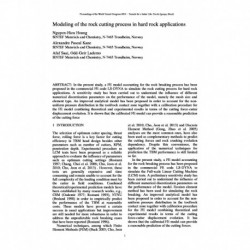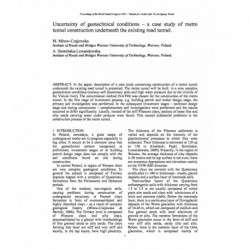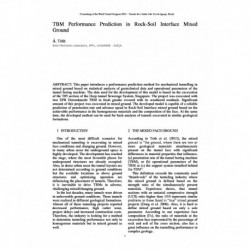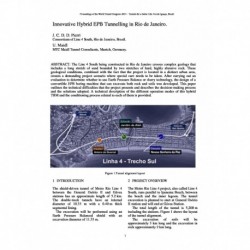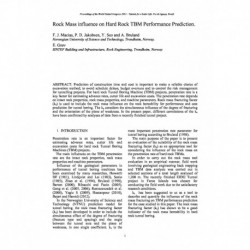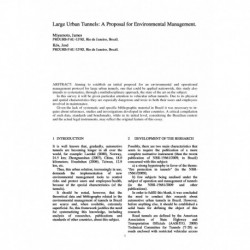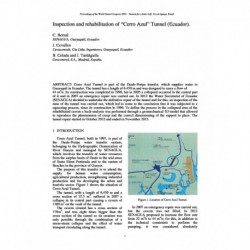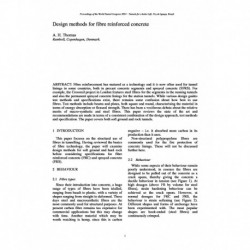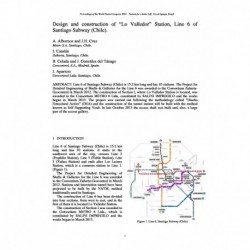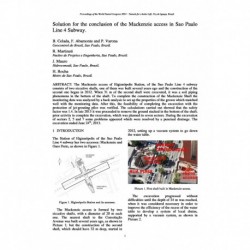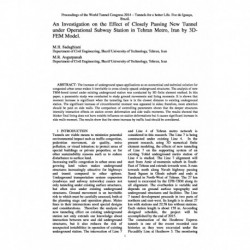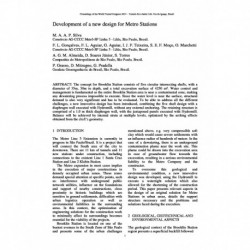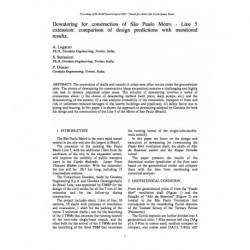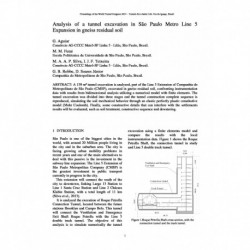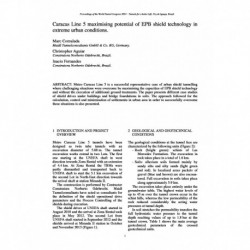No document
Search & filter
Search for a publication
Search & filter
World Tunnelling Congress
WTCThere are 1984 documents.
-
Modeling of the rock cutting process in hard rock applications
Abstract: In the present study, a FE model accounting for the rock breaking process has been proposed in the commercial FE code LS-DYNA to simulate the rock cutting process for hard rock applications. A sensitivity study has been carried out to understand the influence of different numerical discretization parameters on the performance of the model, namely the...
0,00 € -
Uncertainty of geotechnical conditions – a case study of metro tunnel construction underneath the existing road tunnel
Abstract: In the paper, description of a case study concerning construction of a metro tunnel underneath the existing road tunnel is presented. The metro tunnel will be built in a very complex geotechnical conditions (various soft Quaternary soils and high water pressure due to the vicinity of the Vistula river). The conventional method (NATM) was chosen for the construction of the metro tunnel. In the...
0,00 € -
TBM Performance Prediction in Rock-Soil Interface Mixed Ground
Abstract: This paper introduces a performance prediction method for mechanized tunnelling in mixed ground based on statistical analysis of geotechnical data and operational parameters of the tunnel boring machine. The data used for the development of this model is based on the excavation of the T05 section of the Deep tunnel Sewerage System, Singapore. The project was excavated with two EPB...
0,00 € -
Innovative Hybrid EPB Tunnelling in Rio de Janeiro
Abstract: The Line 4 South being constructed in Rio de Janeiro crosses complex geology that includes a long stretch of sand bounded by two stretches of hard, highly abrasive rock. These geological conditions, combined with the fact that the project is located in a distinct urban area, creates a demanding project scenario where special care needs to be taken. After carrying out an evaluation to determine...
0,00 € -
Rock Mass influence on Hard Rock TBM Performance Prediction
Abstract: Prediction of construction time and cost is important to make a reliable choice of excavation method; to avoid schedule delays, budget overruns and to control the risk management for tunnelling projects. For hard rock Tunnel Boring Machine (TBM) projects, penetration rate is a key factor for estimating advance rates, cutter life and excavation costs. The penetration rate depends on intact rock...
0,00 € -
Large Urban Tunnels: A Proposal for Environmental Management
Abstract: Aiming to establish an initial proposal for an environmental and operational management protocol for large urban tunnels, one that could be applied nationwide, this study also intends to systematize, through a multidisciplinary approach, the state of the art on the subject. In this survey it will be given particular attention to vehicular urban tunnels. Due to its physical and spatial...
0,00 € -
Inspection and rehabilitation of “Cerro Azul” Tunnel (Ecuador)
Abstract: Cerro Azul Tunnel is part of the Daule-Peripa transfer, which supplies water to Guayaquil in Ecuador. The tunnel has a length of 6.450 m and was designed to carry a flow of 44 m/s. Its construction was completed in 1996, but in 2005 a collapsed occurred in the central part of it and in 2007 an emergency repair was carried out. In 2012 the Water Secretariat of Ecuador (SENAGUA) decided to...
0,00 € -
Design methods for fibre reinforced concrete
Abstract: Fibre reinforcement has matured as a technology and it is now often used for tunnel linings in some countries, both in precast concrete segments and sprayed concrete (SFRS). For example, the Crossrail project in London features steel fibres for the segments in the running tunnels and also the permanent sprayed concrete linings for the station tunnels. While various design guides test methods...
0,00 € -
Design and construction of “Lo Valledor” Station, Line 6 of Santiago Subway (Chile)
Abstract: Line 6 of Santiago Subway (Chile) is 15.2 km long and has 10 stations. The Project for Detailed Engineering of Shafts & Galleries for the Line 6 was awarded to the Consortium ZañartuGeocontrol in March 2012. The construction of Section I, where Lo Valledor Station is located, was awarded to the Consortium METRO 6 Ltda, constituted by SALINI IMPREGILO and the works began in March 2013. The...
0,00 € -
Solution for the conclusion of the Mackenzie access in Sao Paulo Line 4 Subway
Abstract: The Mackenzie access of Higienópolis Station, of the Sao Paulo Line 4 subway consists of two siccative shafts, one of them was built several years ago and the construction of the second one began in 2012. When 31 m of the second shaft were excavated, it was a soil piping phenomena in the bottom of the shaft. To complete the construction of the Mackenzie Shaft the monitoring data was analyzed by...
0,00 € -
An Investigation on the Effect of Closely Passing New Tunnel FEM Model
Abstract: The increase of underground space applications as an economical and technical solution for congested urban areas makes it inevitable to cross closely spaced underground structures. The analysis of new TBM-bored tunnel under existing underground station was conducted by 3D finite element method. In this paper, a parametric study was conducted to study ground movements and lining moments. It is...
0,00 € -
Development of a new design for Metro Stations
Abstract: The concept for Brooklin Station consists of five circular intersecting shafts, with a diameter of 35m, 30m in depth, and a total excavation surface of 4250 m². Water control and management is fundamental as the entire Brooklin Station area is near a contaminated zone, making any dewatering process impossible to execute. Since the water level is near the surface, structural demand is also very...
0,00 € -
Dewatering for construction of São Paulo Metro - Line 5 extension: comparison of design predictions with monitored...
Abstract: The excavation of shafts and tunnels in urban area often occurs under the groundwater table. The choice of dewatering for construction (deep excavation) remains a challenging and highly risk task in densely populated urban areas. The solution of dewatering involves a series of evaluations about: i) the choice of dewatering method (well point, deep pumps, etc.) and the dimensioning of the...
0,00 € -
Analysis of a tunnel excavation in São Paulo Metro Line 5 Expansion in gneiss residual soil
Abstract: A 139 m² tunnel excavation is analyzed, part of the Line 5 Extension of Companhia do Metropolitano de São Paulo (CMSP), excavated in gneiss residual soil, confronting instrumentation data with results from bidimensional analysis utilizing a numerical model with finite elements. The tunnel excavation was divided into three stages and the tunnel construction complete sequence is reproduced,...
0,00 € -
Exploratory gallery of Radlice tunnel in Prague
Abstract: This paper provides information on the proposed exploratory gallery for Radlice urban road tunnel in Prague which will be a major underground structure of Radlická radial road, which enables the connection of D5 motorway from Germany border with the City road ring in Prague. Due to the complex geological conditions and significant geological risks (deep karst formations) the exploratory gallery...
0,00 € -
Caracas Line 5 maximising potential of EPB shield technology in extreme urban conditions
Abstract: Metro Caracas Line 5 is a successful representative case of urban shield tunnelling where challenging situations were overcome by maximising the capacities of EPB shield technology and without the execution of additional ground treatments. The paper presents different case studies of shield drives under buildings and bridge foundations in soils. The approach followed for the calculation,...
0,00 €

